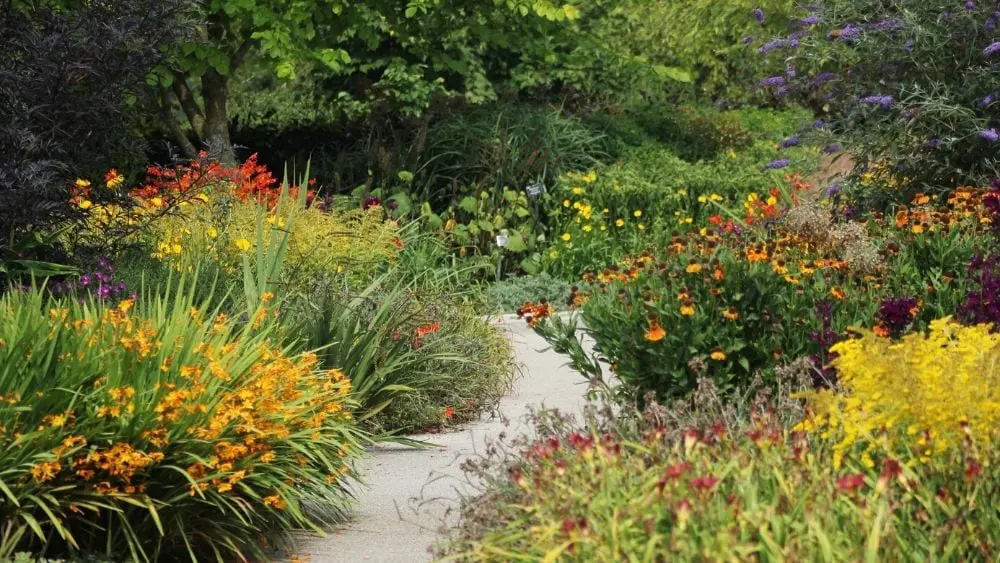
Whether it’s flagstone, bluestone, concrete, boulders or other manmade or natural materials, hardscape — as opposed to vegetative landscape — can be an important and impressive element in any homeowner’s yard.
Used for walkways, steps, retaining walls, borders or columns, hard materials can create focal points, separate plant beds and wooded areas, surround swimming pools and perform many other functions, says Brent Diemer, owner and president of Everett’s Landscape Management in Grand Rapids, Mich.
Bluestone, Flagstone
Bluestone or flagstone can be a fine choice for a walkway, even though the stones are irregularly shaped and challenging for the installer to form into a defined space.
Some bluestone or flagstone paths take a casual approach, more like stepping stones than a full-on walkway. Others are more formal with stones pieced tightly together in an interlocking construction, creating a masterful and artistic effect, Diemer explains.
“The installer is a craftsman,” he says. He or she “does a lot of cutting, chipping and piecing to make that effect happen.”
Bluestone is a sedimentary rock that is formed from particles deposited by lakes, rivers, and oceans. Its rich blue-gray color and moderately textured surface is an asset to patios, pool decks, stone steps, and walk paths. Perks of bluestone include its durability, resistance to slipping and scratching and weather resistance. Flagstone can be “wet-laid” into concrete or “dry-laid” on top of crushed stone, Diemer says. A dry-laid installation might include gravel or decomposed granite, often referred to by the shorthand “d.g.,” for example.
A dry-stone path is permeable to rain water, while a wet-laid one forms a solid surface from which rain water will run off into adjacent areas.
Boulders, Stones, Rocks and Gravel
Whether bluestone, flagstone or some other material, a path can be set off from adjacent areas with boulders, gravel or other stones that are already in place or are added to an installation.
For example, a border of potato stones, which look like the synonymous starchy vegetable, might separate a flagstone path from a patch of ground cover or a more fully planted area.
Diemer says he’s used potato stones that actually came from a potato farm. “One of my customers is a potato farmer,” he says. “The harvester picks both (potatoes and potato stones). They sort through them and the stones are the byproduct of harvesting the potatoes.”
Concrete Pavers
Concrete pavers are a popular choice for hardscape because they’re affordable and come in a wide variety of shapes, sizes and colors. Pavers are most often used for driveways, walkways and patios, but they can be used in other ways, both creative and utilitarian, as well.
Colored pavers can create focal points, like a decorative curved retaining wall or a circular pattern at the foot of a set of stairs. Monochromic pavers can blend into the background and be simply functional.
Pavers also can be new or “tumbled” in a contraption that Diemer says looks like a cement mixer. “They take a perfectly good colored concrete block and they bang it up to distress it, knock the edges off and give it a weathered look,” he says.
Like vintage jeans, pavers create an aged look and are more costly than the unweathered version. An interlocking pathway of distressed brick-red pavers can look remarkably like a vintage brick walkway.
Uses of Pavers
Pavers make good columns, too. A square paver column on top of a wall might support a decorative planter or look-out lamp. A rectangular paver column on the ground might conceal a mailbox. Two square paver columns might surround and support wood pillars to hold a patio swing, suggests Casey Scheidt, hardscapes manager at Hardscapes Outlet in Sioux Falls, S.D.
“The columns hold the beams up for the structural side and the beams hold the swing to give you outdoor relaxation,” Scheidt says.
Retaining or Privacy Walls
Pavers are a good choice for retaining walls, which help to hold back hillsides or protect against water erosion, and privacy walls, which help to screen neighbors’ views into each other’s backyards and create more exclusive and secluded spaces.
One reason why that’s the case is that big pavers can be quite heavy. “The units are so large that the weight of the unit holds it in place,” Scheidt says.
One of Scheidt’s largest installations include a long wide staircase with a circular design of colored concrete pavers at the foot, plus paver columns topped by decorative planters and paver retaining walls that supported plant beds. The installation was built into the side of a hill, creating a more people-friendly alternative to a difficult-to-traverse mound of dirt, he says.
Disappearing Walls
Pavers are so versatile they can even vanish from sight in what’s known as a “green wall.” As Diemer explains, “it’s like you take dresser drawers, stack them and leave room to put plants in them.”
The partially open dresser drawer-like pavers serve as containers for the plants. Over time, the plants can grow to completely cover the wall in which they live, making the plants, rather than the wall, the focal point.
The plants in a green wall don’t have to be all-green, of course. They could be, say, a small flowering ground cover, which would bloom when in season.
A green wall is a good way to make an unwanted wall seem to disappear, though it can take time for that to happen.
With so many choices, you can create the yard of your dreams with a variety of hardscapes and vegetation that suits your style and aesthetic.

Marcie Geffner is an award-winning freelance reporter, writer and editor in Ventura, California. In the last decade, she has penned more than 1,000 published stories about residential and commercial real estate, banking, credit cards, computer security, health insurance and small business, among other subjects. Editors describe her as “detail-driven,” “conscientious,” “smart” and “incredibly versatile.” Her award-winning reporting has been lauded as “rock solid,” “spot-on relevant,” “informative,” “engaging,” “interesting” and “nuanced.” Her stories have been cited in seven published nonfiction books and two U.S. Congressional hearings.
Prior to her freelance career, Geffner was senior editor of California Real Estate magazine. Later, she became managing editor of Inman.com, an independent real estate news website. She also has prior employment experience in technical writing, corporate communications and employee communications. She received a bachelor’s degree in English with high honors from UCLA and master’s degree in business administration (MBA) from Pepperdine University in Malibu, California. She enjoys reading, home improvement projects and watching seagulls at the beach.
 He Said, She Said: What Matters to Men and Women On the Home Front
He Said, She Said: What Matters to Men and Women On the Home Front